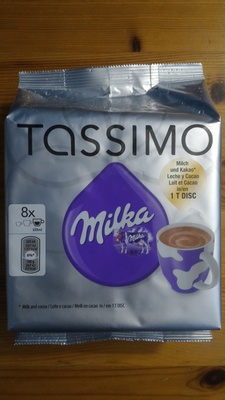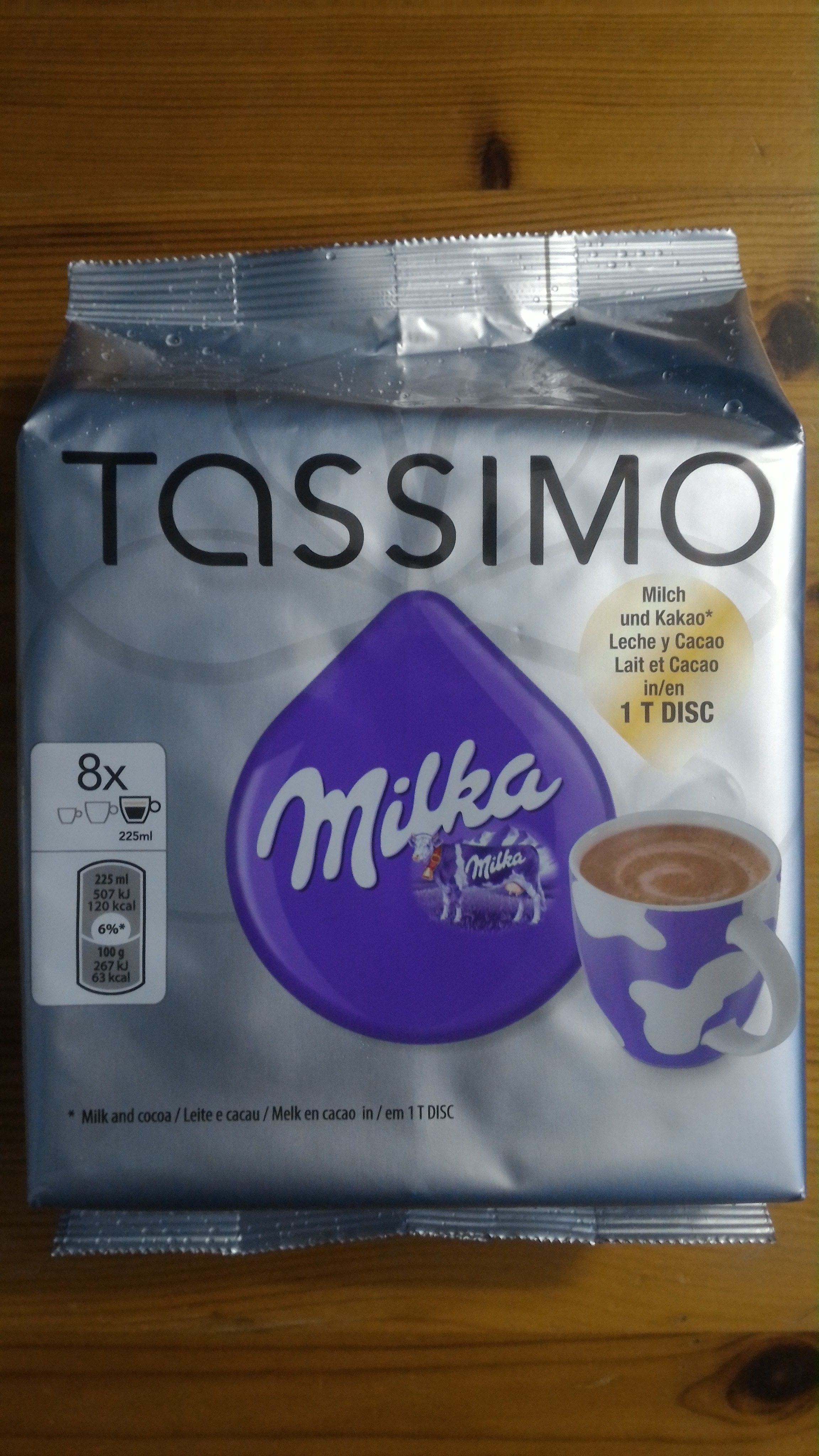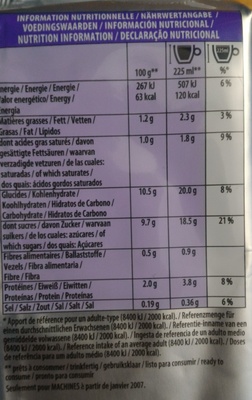Help us make food transparency the norm!
As a non-profit organization, we depend on your donations to continue informing consumers around the world about what they eat.
The food revolution starts with you!
Milka - Tassimo - 240 g
Milka - Tassimo - 240 g
This product page is not complete. You can help to complete it by editing it and adding more data from the photos we have, or by taking more photos using the app for Android or iPhone/iPad. Thank you!
×
Barcode: 7622210288738 (EAN / EAN-13)
Common name: Préparation pour boisson sucrée au cacao avec lait écrémé en poudre
Quantity: 240 g
Packaging: Plastic, Bottle cap, Capsule, Wine cork
Brands: Tassimo
Categories: Beverages and beverages preparations, Beverages, Cocoa and its products, Beverage preparations, Cocoa and chocolate powders, Instant beverages, Capsules, Sweetened beverages, fr:Chocolats chauds
Countries where sold: France
Matching with your preferences
Health
Ingredients
-
18 ingredients
French: Sucre, lait écrémé en poudre (22 %), lait entier en poudre, cacao maigre en poudre (9 %), sirop de glucose, lactosérum en poudre (de lait), graisse de noix de coco totalement hydrogénée, sel, arômes, protéines de lait, stabilisant (E340), anti-agglomérant (E551), émulsifiants (E471, E433, lécithine de soja).Allergens: Milk, Soybeans
Food processing
-
Ultra processed foods
Elements that indicate the product is in the 4 - Ultra processed food and drink products group:
- Additive: E322 - Lecithins
- Additive: E433 - Polyoxyethylene sorbitan monooleate
- Additive: E471 - Mono- and diglycerides of fatty acids
- Additive: E551 - Silicon dioxide
- Ingredient: Emulsifier
- Ingredient: Flavouring
- Ingredient: Glucose
- Ingredient: Glucose syrup
- Ingredient: Milk proteins
- Ingredient: Whey
Food products are classified into 4 groups according to their degree of processing:
- Unprocessed or minimally processed foods
- Processed culinary ingredients
- Processed foods
- Ultra processed foods
The determination of the group is based on the category of the product and on the ingredients it contains.
Additives
-
E322 - Lecithins
Lecithins are natural compounds commonly used in the food industry as emulsifiers and stabilizers.
Extracted from sources like soybeans and eggs, lecithins consist of phospholipids that enhance the mixing of oil and water, ensuring smooth textures in various products like chocolates, dressings, and baked goods.
They do not present any known health risks.
-
E322i - Lecithin
Lecithins are natural compounds commonly used in the food industry as emulsifiers and stabilizers.
Extracted from sources like soybeans and eggs, lecithins consist of phospholipids that enhance the mixing of oil and water, ensuring smooth textures in various products like chocolates, dressings, and baked goods.
They do not present any known health risks.
-
E340 - Potassium phosphates
Potassium phosphate: Potassium phosphate is a generic term for the salts of potassium and phosphate ions including: Monopotassium phosphate -KH2PO4- -Molar mass approx: 136 g/mol- Dipotassium phosphate -K2HPO4- -Molar mass approx: 174 g/mol- Tripotassium phosphate -K3PO4- -Molar mass approx: 212.27 g/mol-As food additives, potassium phosphates have the E number E340.Source: Wikipedia
-
E433 - Polyoxyethylene sorbitan monooleate
Polysorbate 80: Polysorbate 80 is a nonionic surfactant and emulsifier often used in foods and cosmetics. This synthetic compound is a viscous, water-soluble yellow liquid.Source: Wikipedia
-
E471 - Mono- and diglycerides of fatty acids
Mono- and diglycerides of fatty acids (E471), are food additives commonly used as emulsifiers in various processed foods.
These compounds consist of glycerol molecules linked to one or two fatty acid chains, which help stabilize and blend water and oil-based ingredients. E471 enhances the texture and shelf life of products like margarine, baked goods, and ice cream, ensuring a smooth and consistent texture.
It is generally considered safe for consumption within established regulatory limits.
-
E551 - Silicon dioxide
Silicon dioxide: Silicon dioxide, also known as silica, silicic acid or silicic acid anydride is an oxide of silicon with the chemical formula SiO2, most commonly found in nature as quartz and in various living organisms. In many parts of the world, silica is the major constituent of sand. Silica is one of the most complex and most abundant families of materials, existing as a compound of several minerals and as synthetic product. Notable examples include fused quartz, fumed silica, silica gel, and aerogels. It is used in structural materials, microelectronics -as an electrical insulator-, and as components in the food and pharmaceutical industries. Inhaling finely divided crystalline silica is toxic and can lead to severe inflammation of the lung tissue, silicosis, bronchitis, lung cancer, and systemic autoimmune diseases, such as lupus and rheumatoid arthritis. Uptake of amorphous silicon dioxide, in high doses, leads to non-permanent short-term inflammation, where all effects heal.Source: Wikipedia
Ingredients analysis
-
May contain palm oil
Ingredients that may contain palm oil: E471, E433
-
Non-vegan
Non-vegan ingredients: Skimmed milk powder, Whole milk powder, Whey powder, Milk proteins
-
Maybe vegetarian
Ingredients that may not be vegetarian: Whey powder, Flavouring, E471, E433
-
Details of the analysis of the ingredients
fr: Sucre, _lait_ écrémé en poudre 22%, _lait_ entier en poudre, cacao maigre en poudre 9%, sirop de glucose, lactosérum en poudre, graisse de noix de coco totalement hydrogénée, sel, arômes, protéines de _lait_, stabilisant (e340), anti-agglomérant (e551), émulsifiants (e471, e433, lécithine de _soja_)- Sucre -> en:sugar - vegan: yes - vegetarian: yes - ciqual_proxy_food_code: 31016 - percent_min: 22 - percent_max: 60
- _lait_ écrémé en poudre -> en:skimmed-milk-powder - vegan: no - vegetarian: yes - ciqual_food_code: 19054 - percent_min: 22 - percent: 22 - percent_max: 22
- _lait_ entier en poudre -> en:whole-milk-powder - vegan: no - vegetarian: yes - ciqual_food_code: 19021 - percent_min: 9 - percent_max: 22
- cacao maigre en poudre -> en:fat-reduced-cocoa-powder - vegan: yes - vegetarian: yes - ciqual_food_code: 18100 - percent_min: 9 - percent: 9 - percent_max: 9
- sirop de glucose -> en:glucose-syrup - vegan: yes - vegetarian: yes - ciqual_proxy_food_code: 31016 - percent_min: 0 - percent_max: 9
- lactosérum en poudre -> en:whey-powder - vegan: no - vegetarian: maybe - percent_min: 0 - percent_max: 9
- graisse de noix de coco totalement hydrogénée -> en:fully-hydrogenated-coconut-fat - vegan: yes - vegetarian: yes - from_palm_oil: no - ciqual_food_code: 16040 - percent_min: 0 - percent_max: 9
- sel -> en:salt - vegan: yes - vegetarian: yes - ciqual_food_code: 11058 - percent_min: 0 - percent_max: 0.19
- arômes -> en:flavouring - vegan: maybe - vegetarian: maybe - percent_min: 0 - percent_max: 0.19
- protéines de _lait_ -> en:milk-proteins - vegan: no - vegetarian: yes - percent_min: 0 - percent_max: 0.19
- stabilisant -> en:stabiliser - percent_min: 0 - percent_max: 0.19
- e340 -> en:e340 - vegan: yes - vegetarian: yes - percent_min: 0 - percent_max: 0.19
- anti-agglomérant -> en:anti-caking-agent - percent_min: 0 - percent_max: 0.19
- e551 -> en:e551 - vegan: yes - vegetarian: yes - percent_min: 0 - percent_max: 0.19
- émulsifiants -> en:emulsifier - percent_min: 0 - percent_max: 0.19
- e471 -> en:e471 - vegan: maybe - vegetarian: maybe - from_palm_oil: maybe - percent_min: 0 - percent_max: 0.19
- e433 -> en:e433 - vegan: maybe - vegetarian: maybe - from_palm_oil: maybe - percent_min: 0 - percent_max: 0.19
- lécithine de _soja_ -> en:soya-lecithin - vegan: yes - vegetarian: yes - ciqual_food_code: 42200 - percent_min: 0 - percent_max: 0.0633333333333333
Nutrition
-
Nutrient levels
-
Fat in low quantity (1.2%)
What you need to know- A high consumption of fat, especially saturated fats, can raise cholesterol, which increases the risk of heart diseases.
Recommendation: Limit the consumption of fat and saturated fat- Choose products with lower fat and saturated fat content.
-
Saturated fat in moderate quantity (1%)
What you need to know- A high consumption of fat, especially saturated fats, can raise cholesterol, which increases the risk of heart diseases.
Recommendation: Limit the consumption of fat and saturated fat- Choose products with lower fat and saturated fat content.
-
Sugars in high quantity (9.7%)
What you need to know- A high consumption of sugar can cause weight gain and tooth decay. It also augments the risk of type 2 diabetes and cardio-vascular diseases.
Recommendation: Limit the consumption of sugar and sugary drinks- Sugary drinks (such as sodas, fruit beverages, and fruit juices and nectars) should be limited as much as possible (no more than 1 glass a day).
- Choose products with lower sugar content and reduce the consumption of products with added sugars.
-
Salt in moderate quantity (0.19%)
What you need to know- A high consumption of salt (or sodium) can cause raised blood pressure, which can increase the risk of heart disease and stroke.
- Many people who have high blood pressure do not know it, as there are often no symptoms.
- Most people consume too much salt (on average 9 to 12 grams per day), around twice the recommended maximum level of intake.
Recommendation: Limit the consumption of salt and salted food- Reduce the quantity of salt used when cooking, and don't salt again at the table.
- Limit the consumption of salty snacks and choose products with lower salt content.
-
-
Nutrition facts
Nutrition facts As sold
for 100 g / 100 mlAs sold
per serving (225 mL)Compared to: Beverage preparations Energy 267 kj
(64 kcal)601 kj
(144 kcal)-59% Fat 1.2 g 2.7 g -27% Saturated fat 1 g 2.25 g -7% Carbohydrates 10.5 g 23.6 g -64% Sugars 9.7 g 21.8 g -53% Fiber 0.5 g 1.12 g -81% Proteins 2 g 4.5 g -13% Salt 0.19 g 0.427 g +41% Fruits‚ vegetables‚ nuts and rapeseed‚ walnut and olive oils (estimate from ingredients list analysis) 0 % 0 %
Environment
-
Eco-Score E - Very high environmental impact
⚠ ️Select a country in order to include the full impact of transportation.The Eco-Score is an experimental score that summarizes the environmental impacts of food products.→ The Eco-Score was initially developped for France and it is being extended to other European countries. The Eco-Score formula is subject to change as it is regularly improved to make it more precise and better suited to each country.Life cycle analysis
-
Average impact of products of the same category: E (Score: 0/100)
Category: Cocoa or chocolate powder, for beverages, with sugar, fortified with vitamins and chemical elements, non rehydrated
- PEF environmental score: 1.31 (the lower the score, the lower the impact)
- including impact on climate change: 27.10 kg CO2 eq/kg of product
Stage Impact Agriculture
90.9 %Processing
1.4 %Packaging
3.9 %Transportation
3.6 %Distribution
0.3 %Consumption
0.0 %
Bonuses and maluses
-
Missing origins of ingredients information
Malus: -5
⚠ ️ The origins of the ingredients of this product are not indicated.
If they are indicated on the packaging, you can modify the product sheet and add them.
If you are the manufacturer of this product, you can send us the information with our free platform for producers.
-
Packaging with a low impact
Malus: -2
Shape Material Recycling Impact Wine cork Plastic High Capsule Unknown High ⚠ ️ The information about the packaging of this product is not sufficiently precise (exact shapes and materials of all components of the packaging).⚠ ️ For a more precise calculation of the Eco-Score, you can modify the product page and add them.
If you are the manufacturer of this product, you can send us the information with our free platform for producers.
Eco-Score for this product
-
Impact for this product: E (Score: -7/100)
Product: Milka - Tassimo - 240 g
Life cycle analysis score: 0
Sum of bonuses and maluses: -7
Final score: -7/100
-
Carbon footprint
-
Equal to driving 14.0 km in a petrol car
2710 g CO² per 100g of product
The carbon emission figure comes from ADEME's Agribalyse database, for the category: Cocoa or chocolate powder, for beverages, with sugar, fortified with vitamins and chemical elements, non rehydrated (Source: ADEME Agribalyse Database)
Stage Impact Agriculture
95.7 %Processing
0.8 %Packaging
1.8 %Transportation
1.7 %Distribution
0.1 %Consumption
0.0 %
Packaging
-
Packaging with a low impact
-
Packaging parts
Wine cork (Plastic)
Capsule
-
Packaging materials
Material % Packaging weight Packaging weight per 100 g of product Plastic
-
Transportation
-
Origins of ingredients
Missing origins of ingredients information
⚠ ️ The origins of the ingredients of this product are not indicated.
If they are indicated on the packaging, you can modify the product sheet and add them.
If you are the manufacturer of this product, you can send us the information with our free platform for producers.Add the origins of ingredients for this product Add the origins of ingredients for this product
Report a problem
-
Incomplete or incorrect information?
Category, labels, ingredients, allergens, nutritional information, photos etc.
If the information does not match the information on the packaging, please complete or correct it. Open Food Facts is a collaborative database, and every contribution is useful for all.
Data sources
Product added on by gpcu
Last edit of product page on by roboto-app.
Product page also edited by packbot, waann.











